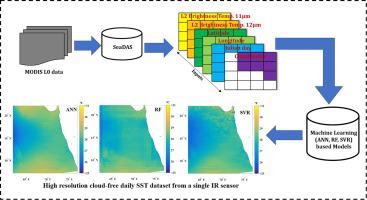ISPRS Journal of Photogrammetry and Remote Sensing ( IF 12.7 ) Pub Date : 2020-06-20 , DOI: 10.1016/j.isprsjprs.2020.06.008 Swathy Sunder , RAAJ Ramsankaran , Balaji Ramakrishnan

|
High-resolution sea surface temperature (SST) estimates are dependent on satellite-based infrared radiometers, which are proven to be highly accurate in the past decades. However, the presence of clouds is a big stumbling block when physical approaches are used to derive SST. This problem is more prominent across tropical regions such as Arabian Sea(AS) and Bay of Bengal(BoB), restricting the availability of high-resolution SST data for ocean applications. The previous studies for developing daily high-resolution cloud-free SST products mainly focus on fusion of multiple satellites and in-situ data products that are computationally expensive and often time consuming. At the same time, it was observed that the capabilities of data-driven approaches are not yet fully explored in the estimation of cloud-free high-resolution SST data. Hence, in this study an attempt has been made for the first time to estimate daily cloud free SST from a single sensor (MODIS Aqua) dataset using advanced machine learning techniques. Here, three distinct machine learning techniques such as Artificial Neural Networks (ANN), Support Vector Regression (SVR) and Random Forest (RF)-based algorithms were developed and evaluated over two different study areas within the AS and BoB using 10 years of MODIS data and in-situ reference data. Among the developed algorithms, the SVR-based algorithm performs consistently better. In AS region, while testing, the SVR-based SST estimates was able to achieve an adjusted coefficient of determination () of 0.82 and root mean square error (RMSE) of 0.71 °C with respect to the in situ data. Similarly, in BoB too, the SVR algorithm outperforms the other algorithms with of 0.78 with RMSE of 0.88 °C. Further, a spatio-temporal and visual analysis of the results as well as an inter-comparision with NOAA AVHRR daily optimally interpolated global SST (a standard SST product available in practice) the suggest that the proposed SVR-based algorithm has huge potential to produce operational high-resolution cloud-free SST estimates, even if there is cloud cover in the image.
中文翻译:

机器学习技术,可根据MODIS数据对高分辨率无云日海表面温度进行区域尺度估计
高分辨率海面温度(SST)估计值取决于基于卫星的红外辐射计,在过去的几十年中,该辐射计被证明是高度准确的。但是,当使用物理方法导出SST时,云的存在是一个很大的绊脚石。这个问题在阿拉伯海(AS)和孟加拉湾(BoB)等热带地区更为突出,从而限制了海洋应用高分辨率SST数据的可用性。以前开发每日高分辨率无云SST产品的研究主要集中在融合多个卫星和现场数据产品上,这些产品计算量大且耗时。同时,观察到在估计无云的高分辨率SST数据时,尚未完全探索数据驱动方法的功能。因此,在这项研究中,我们首次尝试使用先进的机器学习技术从单个传感器(MODIS Aqua)数据集中估算每日无云SST。在这里,使用MODIS的十年经验,开发了三种不同的机器学习技术,例如人工神经网络(ANN),支持向量回归(SVR)和基于随机森林(RF)的算法,并在AS和BoB的两个不同研究领域进行了评估数据和现场参考数据。在已开发的算法中,基于SVR的算法始终具有更好的性能。在AS区域,在进行测试时,基于SVR的SST估算能够实现调整后的确定系数(运用人工神经网络(ANN),支持向量回归(SVR)和基于随机森林(RF)的算法开发了三种不同的机器学习技术,并使用10年的MODIS数据在AS和BoB的两个不同研究领域进行了评估,原位参考数据。在已开发的算法中,基于SVR的算法始终具有更好的性能。在AS区域,在进行测试时,基于SVR的SST估算能够实现调整后的确定系数(运用人工神经网络(ANN),支持向量回归(SVR)和基于随机森林(RF)的算法开发了三种不同的机器学习技术,并使用了10年的MODIS数据在AS和BoB的两个不同研究领域进行了评估,原位参考数据。在已开发的算法中,基于SVR的算法始终具有更好的性能。在AS区域,在进行测试时,基于SVR的SST估算能够实现调整后的确定系数(基于SVR的算法始终表现更好。在AS区域,在进行测试时,基于SVR的SST估算能够实现调整后的确定系数(基于SVR的算法始终表现更好。在AS区域,在进行测试时,基于SVR的SST估算能够实现调整后的确定系数(相对于原位数据而言)为0.82,均方根误差(RMSE)为0.71°C。同样,在BoB中,SVR算法在性能上也优于其他算法0.78的RMSE和0.88°C。此外,对结果进行时空和视觉分析以及与NOAA AVHRR每日最佳内插全局SST(实践中可用的标准SST产品)之间的比较,表明所提出的基于SVR的算法具有巨大的潜力即使图像中有云层覆盖,也可以进行高分辨率的无云SST估算。



























 京公网安备 11010802027423号
京公网安备 11010802027423号